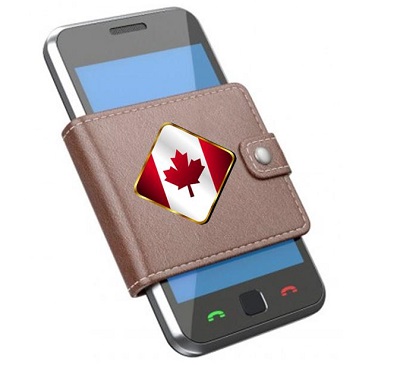While cash purchases are becoming less commonplace in Canada, it’s plastic, not smartphones leading the way.
A new Moneris report revealed that Canadian mobile payments enthusiasm is finally growing. The report’s prediction is that by 2013, only 10 percent of transactions in Canada will be made with cash. In 2014, that figure was still 35 percent.
Digital payment technologies such as mobile wallets will be greatly responsible for reducing cash use.
The 70 percent decline in cash purchases from 2014 through 2030 will be greatly the result of Canadian mobile payments adoption. The number of contactless transactions and mobile wallets in use will reduce the need to carry cash.
 The report indicated that one in four Canadians between the ages of 18 and 34 years old already prefer using a mobile wallet over cash or plastic. Comparatively, only 18 percent feel that way in the 45 to 54 year old age group. Among those from 55 to 64 years old, 10 percent prefer mobile wallets. For those aged 65 and over, only 6 percent would want to use their smartphones instead of cash or credit and debit cards.
The report indicated that one in four Canadians between the ages of 18 and 34 years old already prefer using a mobile wallet over cash or plastic. Comparatively, only 18 percent feel that way in the 45 to 54 year old age group. Among those from 55 to 64 years old, 10 percent prefer mobile wallets. For those aged 65 and over, only 6 percent would want to use their smartphones instead of cash or credit and debit cards.
That said, there remain some very specific barriers to Canadian mobile payments adoption.
Leger conducted a survey in which there were 1,516 Canadian participants. When asked why they would choose not to use a mobile wallet, 62 percent had their doubts about security. They said they would be more likely to use smartphones to make purchases if they felt confident in mobile security.
Moreover, 42 percent said they’d be interested in using mobile payments if there were more stores that accepted those transactions. Another 50 percent said they would be interested in using smartphone payments if it meant they could leave all their plastic loyalty cards at home.
The report also showed interest in some of the additional opportunities offered by Canadian mobile payments. For example 48 percent of those surveyed said they would use a mobile wallet if they were emailed a receipt. Furthermore, 46 percent said they would use it if all stores accepted the technology. Moreover, 41 percent said they would be interested in using them if they could also store their ID on their phones so they could leave their entire wallets behind. Another 35 percent said they would use mobile payments to pay for public transportation fare.
UK shows that success in the mobile commerce space is quite possible
The United Kingdom may be leading the United States when it comes to mobile payments. The latest statistics coming from the UK Cards Association show that one in 10 card transactions are now made through mobile devices using contactless systems. This has grown considerably over what it had been in the last year. In the U.S., mobile payments are still fighting to find a foothold among consumers for various reasons. If companies operating in the mobile commerce space want to ensure success in the country, they may have to look elsewhere for inspiration.
Apple Pay is fighting for a foothold in the United States
In the U.S., consumers are interested in mobile commerce, but relatively few participate in this space. Apple Pay, one of the country’s more popular mobile payments services, has found only modest success, with only 3.5% of mobile transactions actually being completed through the platform. This is actually lower than the transactions that Apple Pay accounted for in March of 2015, which stood at 5.9%. Fewer people are now using Apple Pay than in the past and this is a trend that is being seen with other mobile payments services as well.
Ubiquity may be the key to success
 It companies in the United States’ mobile commerce market want to succeed, they may have to focus on ubiquity. This is something that the UK market has accomplished quite well. The country is home to the most heavily concentrated banking and acquiring segments and retailers in the country serve a very well defined geographic market. Barclays, one of the country’s largest banks, accounts for more than 40% of all credit and debit card spending. The country also has a multitude of merchant acquire options. What this means is that if Barclays backs mobile transactions, it is extremely easy for retailers to accept payments being made from mobile devices, something that is not readily apparent in the U.S. market.
It companies in the United States’ mobile commerce market want to succeed, they may have to focus on ubiquity. This is something that the UK market has accomplished quite well. The country is home to the most heavily concentrated banking and acquiring segments and retailers in the country serve a very well defined geographic market. Barclays, one of the country’s largest banks, accounts for more than 40% of all credit and debit card spending. The country also has a multitude of merchant acquire options. What this means is that if Barclays backs mobile transactions, it is extremely easy for retailers to accept payments being made from mobile devices, something that is not readily apparent in the U.S. market.
Mobile commerce is growing in Australia and Canada at well
The UK is not the only country where mobile commerce is flourishing, of course. Both Australia and Canada have rapidly growing mobile commerce markets, which are becoming more competitive with what has already been established in the U.S. While mobile payments are having trouble finding momentum in the U.S., the market is still quite attractive to companies that want to provide consumers with new mobile services. There may need to be a greater focus on ubiquity in order to ensure future success, however.
 The report indicated that one in four Canadians between the ages of 18 and 34 years old already prefer using a mobile wallet over cash or plastic. Comparatively, only 18 percent feel that way in the 45 to 54 year old age group. Among those from 55 to 64 years old, 10 percent prefer mobile wallets. For those aged 65 and over, only 6 percent would want to use their smartphones instead of cash or credit and debit cards.
The report indicated that one in four Canadians between the ages of 18 and 34 years old already prefer using a mobile wallet over cash or plastic. Comparatively, only 18 percent feel that way in the 45 to 54 year old age group. Among those from 55 to 64 years old, 10 percent prefer mobile wallets. For those aged 65 and over, only 6 percent would want to use their smartphones instead of cash or credit and debit cards.
 It companies in the United States’ mobile commerce market want to succeed, they may have to focus on ubiquity. This is something that the UK market has accomplished quite well. The country is home to the most heavily concentrated banking and acquiring segments and retailers in the country serve a very well defined geographic market. Barclays, one of the country’s largest banks, accounts for more than 40% of all credit and debit card spending. The country also has a multitude of merchant acquire options. What this means is that if Barclays backs mobile transactions, it is extremely easy for retailers to accept payments being made from mobile devices, something that is not readily apparent in the U.S. market.
It companies in the United States’ mobile commerce market want to succeed, they may have to focus on ubiquity. This is something that the UK market has accomplished quite well. The country is home to the most heavily concentrated banking and acquiring segments and retailers in the country serve a very well defined geographic market. Barclays, one of the country’s largest banks, accounts for more than 40% of all credit and debit card spending. The country also has a multitude of merchant acquire options. What this means is that if Barclays backs mobile transactions, it is extremely easy for retailers to accept payments being made from mobile devices, something that is not readily apparent in the U.S. market.